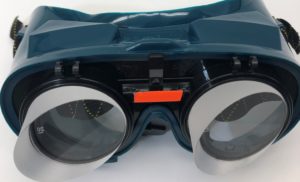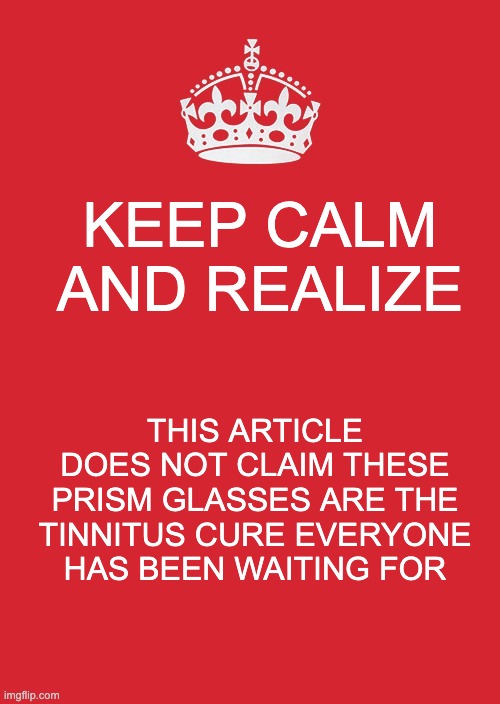New research project will investigate the therapeutic effects of a short exposure to prisms on hearing deficits of tinnitus.
Could special glasses offer relief to people with tinnitus? According to the science, it’s not such a crazy question…

And a research project (led by Carine Michel) dedicated to finding out the answer has received a grant worth 213,408 euros (around $250,000 USD) from the ANR (France’s Agence Nationale De La Reserche).
Yes, the glasses may seem gimmicky, at first. But the science is fascinating…
From the official project description (emphasis ours):
Glasses to ear differently – GLAD
Our project aims at better understanding the link between visuo-motor plasticity (by using a short exposure to glasses shifting the visual field) and auditory perception to propose an innovative therapeutic method to reduce hearing loss. There are many evidences showing the therapeutic effects of prism adaptation on lateralized impairments, while our recent innovative result shows the effect of prism adaptation on auditory perception in healthy individuals (Michel et al., 2019; Bonnet et al., submitted).
Our project has two main objectives:
1) from a fundamental point of view, we will deepen our understanding of the effects of prism adaptation on auditory processes in healthy participants, and
2) from a clinical point of view, we will investigate the therapeutic effects of a short exposure to prisms on hearing deficits of tinnitus and presbycusis.
Importantly, this avenue of research builds on recent studies related to “visuo-motor plasticity” and something called “cross-modal enhancement”.
In short, the idea that tinkering with one sense (such as vision) can have an effect on another sense (such as hearing). And, hopefully, in a predictable way… that will allow such tinkering to perhaps someday serve as a volume knob for tinnitus. Or augment auditory perception by using the auditory’s connections to eyesight and visual areas of the brain (becoming well-established).
Some background and related research:
Modifying auditory perception with prisms? Aftereffects of prism adaptation on a wide auditory spectrum in musicians and nonmusicians
December 2020
https://www.sciencedirect.com/science/article/pii/S0001691820305436
Prism adaptation consists of pointing to visual targets while wearing prisms that shift the visual field laterally. The aftereffects are not restricted to sensorimotor level but extend to spatial cognition. There is a link between spatial representation and auditory frequency, with an association of low frequencies on the left side and high frequencies on the right side of space.
Influence of Visual Prism Adaptation on Auditory Space Representation
https://journals.sagepub.com/doi/full/10.1177/2041669517746701
We here show that there is indeed a slight influence of visual adaptation on the perceived direction of acoustic sources.
The research dollars appear to be attracted as well…
The Swiss National Science Foundation also recently funded a project related to audio-visual cross-modal effects: “Cross-modal interaction after brain lesion – the influence of auditory stimulation on visual neglect”. The project began earlier this year and will continue until February 2025.
From the project description (emphasis ours):
The relevance of our project is twofold. First, the project will shed light on the neuronal mechanisms underlying audio-visual cross-modal effects. Second, by clarifying how and to which degree audio-visual cross-modal effects may improve visuospatial attention in neglect patients, the project will potentially allow to develop new therapeutic approaches.
And if the connection to tinnitus still seems like a stretch… consider this paper from last year, “Increased risk of tinnitus in patients with early-onset cataracts: a nationwide population-based case-control study”, which concluded that “patients with early-onset cataract are at an increased risk of developing tinnitus in subsequent years”.
Note: that particular paper points to ROS (reactive oxygen species) as the main contributing factor… but it’s hard to ignore the eye-ear connection given the other emerging research and ongoing projects on the topic.
It gets the noggin’ joggin’:
Could a change in eyesight create a mismatch in auditory perception, and influence the central gain cause of tinnitus?
Hmmm…
It’s certainly a fair question.
Which might explain why some other big, familiar institutions are also investigating this vision-tinnitus axis.
For instance, this Johns Hopkins University project that began last July. Titled, “Cross-modal enhancement of auditory plasticity and performance in adults”, the project has received nearly $1 million USD in funding so far and will continue until June 2025, if everything goes as planned.
The project aims to discover the “mechanisms that can recover adult cortical plasticity is of essence to benefit recovery of hearing or for treating abnormal auditory processing as occurs with tinnitus.”
Here is the full project description — certainly worth a read (formatting and emphasis ours):
Cross-modal enhancement of auditory plasticity and performance in adults
It is well documented that the ability of the brain to undergo plasticity becomes limited in adults. In particular, sensory experience-dependent plasticity of cortical circuits is rather confined to a limited time during development, termed the critical period. Recovery and refinement of sensory processing is therefore difficult in adults. For example, the success rate of speech recognition in artificial cochlear implant patients becomes quite low, if the surgery is done later in life.
Hence discovery of mechanisms that can recover adult cortical plasticity is of essence to benefit recovery of hearing or for treating abnormal auditory processing as occurs with tinnitus.
We found that temporary visual deprivation is quite effective at producing large-scale plasticity in the adult primary auditory cortex (A1) of mice. Such changes occurred as potentiation of feedforward excitatory synapses from the primary auditory thalamus (MGBv) to layer 4 (L4) as well as L4 to L2/3. This was accompanied by weakening of synapses arising from lateral intracortical sources to L2/3 of A1. In parallel, we also observed refinement of cortical circuits of A1 L4 and L2/3. Collectively, these changes suggest that A1 circuit adapts to allow better processing of bottom-up auditory inputs, which is consistent with our published observation of refinement of A1 L4 neuronal receptive field and lowering of detection threshold in visually deprived mice. In this application, we aim to determine the mechanisms involved in driving adult A1 plasticity with visual deprivation, and whether visual deprivation improves auditory behavior in adults. Based on our observation that visual deprivation induced potentiation of thalamocortical (TC) inputs to A1 L4 requires audition, but no due to changes in the auditory environment, we surmise that there is central adaptation in circuits mediating auditory signals going through the thalamus and the cortex.
In particular, we hypothesize that short-term visual deprivation promotes A1 plasticity in adults by regulating inhibitory circuits at the level of thalamus and cortex (Aim 1). The circuit and synaptic adaptation seen in A1 following vision loss accompanied refinement of A1 L4 neural function, and is predicted to enhance auditory function.
We will examine how short- term visual deprivation alters auditory behavioral tasks in adults, and investigate whether this is due to changes in A1 neuronal responses and population encoding during auditory tasks using in vivo 2-photon imaging (Aim 2).
Results from our proposed study will provide mechanistic understanding on how short-term visual deprivation enables plasticity of adult A1 via regulation of thalamic and cortical circuits, and will provide means to enhance auditory processing in the adult brain that could benefit development of treatment options for enhancing or recovering auditory function as would be needed for better prognosis of artificial cochlear implants. Furthermore, our results can be generalized to provide insights into how cortical circuits adapt to losing major inputs as it may happen during injury, stroke, and neuronal degeneration.
Public Health Relevance
Discovering mechanisms to enhance adult brain function is of utmost importance when devising therapeutics to recover and refine normal brain function later in life. We found that temporarily depriving vision leads to recovery of plasticity in the adult auditory cortex, which can benefit auditory function. In this proposal, we aim to determine the mechanisms that allow recovery of adult brain plasticity, and whether temporary visual deprivation improves auditory performance in adults.
Interesting.
And perhaps even substantial enough to give those “gimmicky” glasses — which could potentially increase auditory perception (via multiple mechanisms)… and possibly alter or diminish tinnitus perception (to be determined) — some legitimacy. And in the context of all this research, perhaps this anti-tinnitus glasses project happening in France does not seem so “wacky” anymore…
But first, a quick rant:
Speaking of “wacky”, I have noticed an influx of Hope Police commenting on my articles and notes. “Hope Police” is the label I assign to people who feel the need to protect others from False Hope. They can be found commenting on articles like this one in Facebook groups or Reddit posts. They are easy to spot because they are Very Serious about making it clear that “THIS IS NOT THE TINNITUS CURE EVERYONE HAS BEEN WAITING FOR” and other variations of “NOTHING TO SEE HERE, KEEP IT MOVING.” In reality, what they really spread is False Nope. The opposite of False Hope and… a much bigger villain. Often these Hope Police and Protectors of Truth do not even bother reading the article. And so their criticisms are limited to the atmosphere of the article… what the article implied, apparently… or, get this… they explain how the problem with the article is that it could potentially be perceived by someone as suggesting the treatment in question is a cure. In other words, these Hope Police protect imaginary people from imaginary scenarios involving imaginary problems. Anyway, if you can’t already tell… it bugs me. But after giving it some more thought, I have decided to take the high road and… instead of publicly shaming these straw-treatment “debunkers”… I have decided to offer them a very special meme that will hopefully clear things up:

That’s a peace offering.
As for everyone else…
I offer an invitation to join the newsletter (email updates)… that gives you “early access” to tinnitus treatment-related news and updates (that you won’t find anywhere else) — mostly pertaining to experimental not-yet-available tinnitus therapies. I send 1-2 issues per week. But only when something good is happening. See link below:
Updates
If you would like updates on the development of these “anti-tinnitus prism adaptation glasses” (as well as other experimental tinnitus-related treatments and not-yet-released drugs), subscribe to the email newsletter.
Last but not least, references for this [draft] article.
References
- https://anr.fr/Project-ANR-20-CE28-0022
- https://bmcophthalmol.biomedcentral.com/articles/10.1186/s12886-020-01497-8
- https://www.sciencedirect.com/science/article/pii/S0001691820305436
- https://journals.sagepub.com/doi/full/10.1177/2041669517746701
- http://p3.snf.ch/project-196915
- For people who want to know how much these glasses cost or where to get them… I do NOT have an answer. But I do have a link to share. Not advice, not a treatment suggestion, not advice. Just a link. So, please keep in mind that the glasses you are about to see, via the following link, will almost certainly NOT be the same glasses (nor use the same “settings” or therapeutic approach) as those that may potentially treat hearing loss or reduce tinnitus. But if you are still curious, here is what “anti-tinnitus glasses” might look like: https://www.stoeltingco.com/kessler-foundation-prism-adaptation-treatment-kf-pat-for-spatial-neglect.html #tradeoffs #wouldyourather
- Fun fact: The idea of using lenses to change perception and affect other senses — the field of “psychological optics”, as it was called — dates back to the late 1800s: Helmholtz, H. (1867) Manual of psychological optics, Leipzig, Germany: Leopold Voss.
- Project reference: CAPS COGNITION, ACTION ET PLASTRICITE SENSORI-MOTRICE – U 1093. LEAD LABORATOIRE D’ETUDE DE L’APPRENTISSAGE ET DU DEVELOPPEMENT – UMR 5022